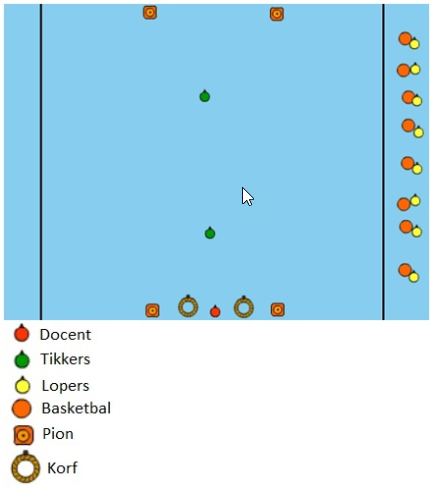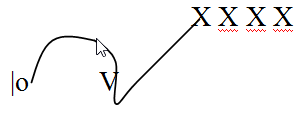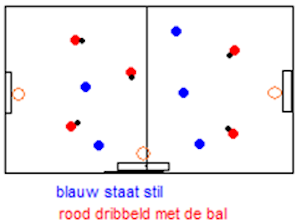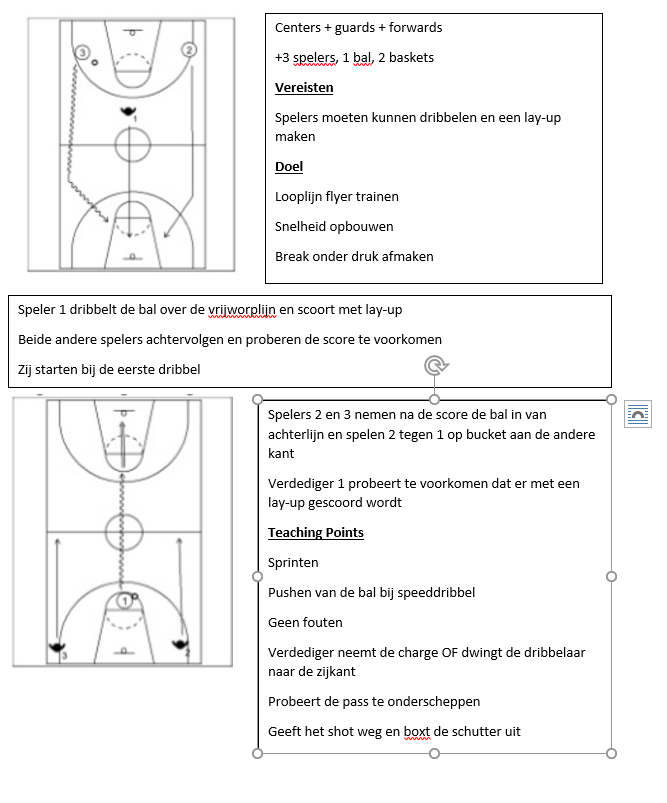Basketball drills for technique dribbling
- The teacher chooses 2 tickers.
- They have to stay inside their box (inside the 4 pawns) and knock the basketballs away from the runners when they want to cross.
- The runners have to dribble to the other side without losing their basketball.
- If a runner doesn't have his basketball with him, he's out and he automatically becomes a ticker.
- A tip that you can give to the runners is that they should shield the ball with their body.
- This means staying between the ball and the opponent.
- The pupils may only cross again when everyone has been tagged or has reached the other side.
- In the end, as the game progresses, you get more and more tickers and less and less runners.
- The last remaining runner is the winner.

- We're gonna dribble!
- Dribble the ball from left to right.
- With feints in between. High. Low. Fast and slow.
- Look closely at the options you have.
- The planet Saturn is the planet with the rings.
- So can you guess how the Saturn exercise goes?
- Spin the ball around your left leg, your right leg and around both legs.
- There is no dribbling involved, but this exercise is very good for your hand-eye coordination.
- The players bounce the ball on the spot.
- Make sure the hand is always on the ball so the ball is pushed down (so not hit down).
- The players sink through their knees so they are low to the ground and the ball bounces faster.
- Then the players stretch their knees again. Repeat several times.
- The players dribble through each other, changing direction all the time so that they are criss-crossing each other.
- The players must try not to touch each other.
- The players try to guide the ball along a route whilst dribbling.
- For example slalom around cones or over benches (at your own discretion).
- Place a row of cones and give each child its own basketball.
- The children are challenged to dribble around the cones.
- They are not allowed to hit the cones and they are not allowed to lose their ball.
- The children follow each other quietly. The pace is gradually increased.
- When the children get more ball control, put another row of cones parallel to the first row.
- Let the children play a game: the first one who manages to dribble around the cones without a fault has won.
- Let the winners play against each other, until only one winner remains.
- A good basketball exercise for more ball control.
Feint exercise
- Walk towards the defender, move your left foot to the left, as if you were passing the defender on the left
- Immediately afterwards, move your left foot to the right and get the ball very low from your left hand to your right hand, so that your back is facing your opponent
- Now dribble on and score with the lay-up

- Half of the basketball players have a ball.
- These basketball players dribble all over the room.
- On the whistle they pass the ball to someone they first made eye contact with.
- The pass they use to do so is up to them.
- Choose the pass that is best in the situation.
- If you are close to the ball, do not pass.

Warm-up
- dribble over and over again right hand
- dribble over and left hand again
- low dribble over and right again
- low dribble over and to the left
- high dribble over and right again
- high dribble over and left again
- protection dribble with a hand change every 2 or 3 dribbles (2 times over and over)
- quick dribble over and over again with crossover at the free throw centre and free throw line.
Try to hit as far as possible without error or loss of ball.
- Players stand in pairs (about the same size).
- On the whistle, the player with the ball dribbles to the opposite side while the player without the ball can do heavy defence.
- There may be physical pressure but no mistakes.
- Players stop when they have lost control of the ball or when the defence has taken it away.
- If the player with the ball touches the opposite side, he may dribble again in the next round but against a different defence.
- Divide the players into 2 groups.
- Set up a track on both sides of the court where the players have to dribble in between.
- At the end of the course they can finish on goal.
- three groups of two per basket
- try to make qualitatively equal pairs
- How?
- 1 pair in front, 2 in forward positions
- take turns making a drive, alternating attack/defence
- First of the pair to have 5 points, wins.








